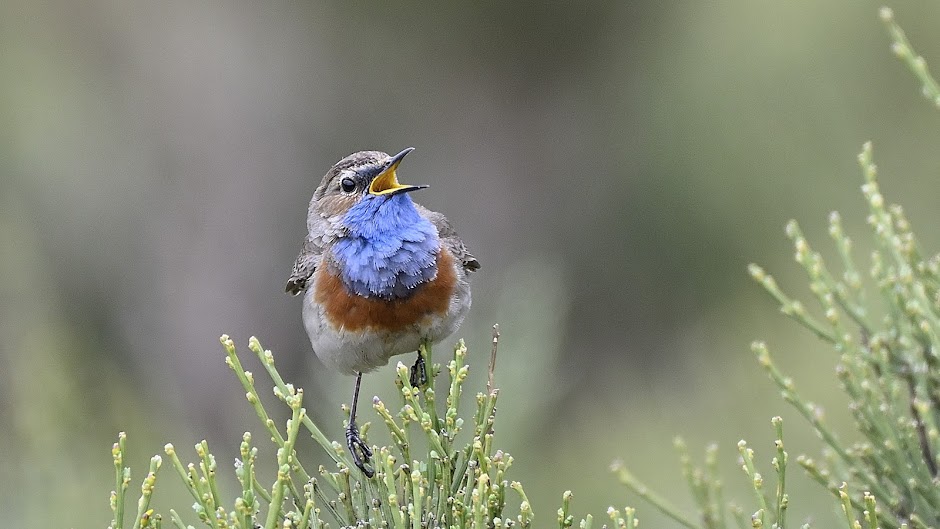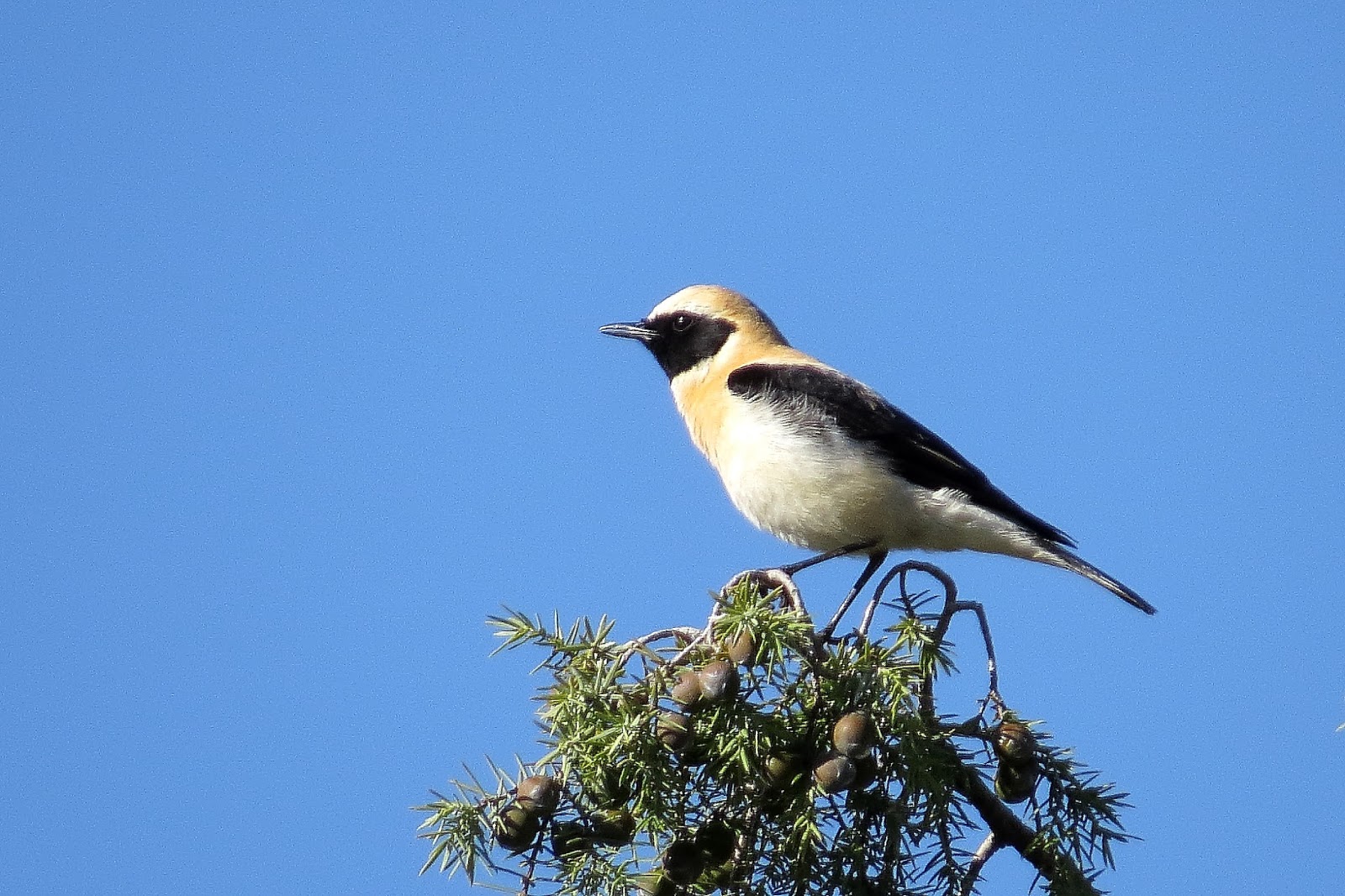Esta vez nos vamos a dar una vuelta por el Parque Natural de las Hoces del Río Duratón situado al noreste de la provincia de Segovia. La primera parte de la visita consistió en ir hasta la Ermita de San Frutos en una extensa paramera que acaba en la propia Ermita para disfrutar de aves de este entorno y después adentrarse en el propio cañón para disfrutar de las aves rupícolas.
This time we're going to take a walk around the Parque Natural de las Hoces del Río Duratón in the northeast of the province of Segovia. The first part of the visit consisted of going to the Ermita de San Frutos in a vast moorland which finishes in it to enjoy birds related to this environment and then into the canyon itself to observe the Rock-dwelling Birds.
El tiempo nos acompañó y disfrutamos de un día bastante soleado y con buena temperatura.
Weather was good and we enjoyed a fairly sunny day with a nice temperature.
En nuestro recorrido hasta la Ermita pudimos oír la escasa alondra ricotí además de ver a casi todo el resto de la familia de las alondras a excepción de la terrerra común, que no había llegado aun, y la terrera marismeña que no habita en esta zona de la Península.
In our tour to the Hermitage we could hear the scarce Dupont's Lark plus see most of the rest of the Larks except the Short-toed Lark that was not arrived yet and the Lesser Short-toed Lark which do not inhabits this area of the Peninsula.
Este buitre leonado (Gyps
fulvus) tomaba el sol a primera hora de la mañana.
This Griffon Vulture was sunbathing early in the morning.
Al igual que este mochuelo europeo (Athene
noctua).
Just like this Little Owl.
Ya adentrados en la paramera lo primero que vimos fue este precioso macho de collalba rubía (Oenanthe
hispanica).
Already through the Moorland first bird we saw was this beautiful male of Black-eared Wheatear.
La más abundante de las alondras eran las cogujadas comunes (Galerida
cristata).
The most abundant of the Larks were the Crested Larks.
Las calandrias (Melanocorypha
calandra) también estaban presentes.
Calandra
Larks were also present.
Y las totovías (Lullula
arborea). Todas ellas en pleno celo y cantando primorosamente.
And Wood Larks. All of them in breeding season singing beautifully.
Cuando caminábamos hacia la Ermita los buitres leonados (Gyps fulvus) empezaron a levantar el vuelo ayudados por las corrientes térmicas.
While we were walking towards the Hermitage Griffon Vultures started to take off aided by thermals.
Vista de la Ermita de San Frutos y del embalse de Burgomillodo.
View of the Hermitage of San Frutos and Burgomillodo Reservoir.
Vista desde la Ermita hacia la presa del embalse.
View from the Hermitage to the dam of the reservoir.
Y después de disfrutar un rato de las hermosas vistas nos sorprendió esta águila calzada (Aquila
pennata) fase clara.
And after a while enjoying the beautiful views we were surprised by this white phase Booted Eagle.
Las chovas piquirrojas (Pyrrhocorax
pyrrhocorax) nos pasaban muy cerca de donde estábamos.
Red-billed
Choughs passed very close to where we were.
Buitres leonados (Gyps fulvus).
Griffon Vultures.
Vista del Monasterio y la Ermita. Ésta construcción románica es del siglo XII que fue realizada sobre otra visigotica del siglo VII. Su fundación se atribuye a San Frutos y sus dos hermanos, San Valentín y Santa Engracia. Con posterioridad se construyeron el monasterio y un cementerio.
View of the Monastery and the Hermitage. This Romanesque building is from the twelfth century and was performed on top of another Visigothic from the seventh-century . Its foundation is attributed to San Frutos and his two brothers, San Valentine and Santa Engracia. Later the monastery and a cemetery were built.
También sobrevolaban la zona algunos cuervos (Corvus
corax).
Also some Common
Ravens flew overhead.
En los acantilados del lugar se podían ver nidos de buitres leonados (Gyps fulvus) con pollos y a sus padres cebándolos.
On the cliffs of the area could be seen nests of Griffon Vultures with their chickens been fed by their parents.
Y este par de alimoches comunes (Neophron
percnopterus) fueron los primeros que vimos.
And this pair of Egyptian
Vultures were the first we saw.
En nuestro camino de regreso volvimos a disfrutar de bastantes especies de aves. En la foto una alondra común (Alauda arvensis).
On our way back we again enjoy many species of birds. In the photo a Sky Lark.
Y en esta otra una cogujada montesina (Galerida
theklae).
And in this one a Thekla Lark.
Las abubillas europeas (Upupa
epops) estaban muy cantarinas.
The Eurasian Hoopoes were very singsong.
Esta fue la única collalba gris (Oenanthe
oenanthe) que vimos en todo el día. Una hembra.
This was the only Northern Wheatear we saw all day long. A female.
También había algunas tarabillas europeas (Saxicola rubicola). En la foto un bonito macho.
There were also some Common
Stonechat. In the photo a pretty male.
Ya en el aparcamiento del Puente de Talcano había algunos gorriones chillones (Petronia
petronia).
Already in the parking of Puente de Talcano there were some Rock
Sparrows.
Nuestro siguiente recorrido transcurrió desde el citado puente hasta el Puente de Villaseca. Según bajábamos hacia la citada senda este petirrojo (Erithacus
rubecula) nos entretuvo con su melodioso canto.
Our next route was since the abovementioned bridge to the Puente de Villaseca. As we walked down towards the river path this Robin entertained us with their melodious singing.
Al igual que este macho de verdecillo (Serinus
serinus).
Just like this male of European Serin.
Las chovas piquirrojas (Pyrrhocorax pyrrhocorax) estaban utilizando oquedades en los cortados para construir sus nidos.
Red-billed Choughs were using hollows in the cliffs to build their nests.
Alguno de los nidos de los buitres leonados (Gyps fulvus) estaban en salientes demasiado pequeños y se podía ver las plumas traseras de los reproductores.
Some of the Griffon Vultures nests were made in ledges too small and you could see the tail feathers of broodstock.
A lo largo del cañón se podían observar muchos buitres leonados (Gyps fulvus).
Throughout the canyon you could see many Griffon Vultures.
Y también pudimos observar varias parejas de alimoches comunes (Neophron percnopterus).
And we could also observe several pairs of Egyptian Vultures.
Este halcón peregrino (Falco
peregrinus) nos entretuvo un buen rato con sus idas y venidas a toda velocidad. Demasiado rápido para mi cámara.
This peregrine falcon entertained us a while with its comings and goings at a high speed. Too fast for my camera.
Y un poco después hizo acto de presencia esta águila real (Aquila
chrysaetos). Durante el paseo vimos cuatro ejemplares en distintos sitios y siempre en solitario.
A little later showed up this Golden Eagle. During the walk we saw four individuals in different places and always one by one.
Había bastantes currucas capirotadas (Sylvia
atricapilla) fáciles de ver pero difíciles de fotografiar.
There were quite a few Blackcaps easy to see but difficult to photograph.
Cuando regresábamos pudimos observar una disputa territorial entre dos parejas de alimoches comunes (Neophron percnopterus). Estuvimos durante una media hora observándo como se peleaban.
When returning we could observe a territorial dispute between two pairs of Egyptian Vultures. We stayed for a half hour watching them as they fought.
Mientras tanto este macho de roquero solitario (Monticola
solitarius) estaba cantando.
Meanwhile this Blue Rock Thrush male was singing.
Muy poco tiempo permanecían posados los alimoches comunes (Neophron percnopterus) pues venia otro y le expulsaba.
Egyptian Vultures remained perched very little because another came and expelled it.
Con tanto alboroto hizo acto de presencia esta preciosa águila real (Aquila chrysaetos) que como podéis apreciar había comido bastante.
With all this fuss made its appearance this lovely Golden Eagle (Aquila chrysaetos), which as you can see had eaten enought.
En un momento determinado la cosa estaba más que animada y pude captar esta foto con un águila real (Aquila
chrysaetos), un alimoche común (Neophron
percnopterus) y un cernícalo vulgar (Falco
tinnunculus).
At a given time things were more than animated and I was able to capture this photo with a Golden Eagle, an Egyptian Vulture and a Common Kestrel.
Maravillosa ave.
Gorgeous bird.
Y otra más del águila real (Aquila chrysaetos) y un alimoche común (Neophron percnopterus).
And another one of the Golden Eagle and an Egyptian Vulture.
También vimos muchos petirrojos (Erithacus
rubecula).
We also saw many Robins.
Al cabo de un rato vimos este ejemplar inmaduro de águila real (Aquila chrysaetos). Mas tarde nos encontramos con uno de los guardas del Parque y nos comentó que a pesar de su edad ya se había emparejado y que estaba criando no muy lejos de donde la vimos.
After a while we saw this immature specimen of the Golden Eagle. Later we find one of the park rangers and told us that despite hit age had already been paired and was breeding not far from where we saw it.
A media tarde los buitres leonados (Gyps fulvus) empezaron a llegar a sus dormideros después de haber pasado el día buscando alimento.
By midafternoon Griffon Vultures started to come to their roosting places after spending the day looking for food.
Y esta fue la última águila real (Aquila chrysaetos) que vimos.
And this was the last Golden Eagle we saw.
Muchos mirlos comunes (Turdus
merula) nos entretuvieron a lo largo de la jornada con sus maravilloso canto.
Many Blackbirds entertained us throughout the day with their wonderful singing.
También vimos dos culebreras europeas (Circaetus
gallicus).
We also saw two Short-toed
Eagles.
Y muchos pinzones vulgares (Fringilla
coelebs). En la foto un macho.
And many Chaffinches. Pictured a male.
Y antes de regresar a Madrid este triguero (Miliaria
calandra) nos dijo adios.
And before returning to Madrid this Corn Bunting said to us goodbye.
Espero que no os haya aburrido mucho con este relato y hasta pronto.
I hope you have not bored a lot with this story and see you soon.




































































Hola, Luis. Fantástico día de pajareo tuviste. A ver si me paso pronto por allí, porque hace muchos años que no voy y tengo muchas ganas de volver a echarle un vistazo.
ResponderEliminarMe surge una duda con una de tus identificaciones. Parece que estás muy seguro cuando distingues a las cogujadas común y montesina. Sin embargo, hace unos día hubo un "encendido debate" en Avesforum ya que se argumentaba que la única forma de distinguir con seguridad ambas especies era en mano según la longitud de determinadas plumas.
¿Qué criterio utilizas tú para distinguirlas? (Que conste que no estoy poniendo en duda nada y que mi habilidad para diferenciar aláudidos está cercana a cero).
Muchas gracias.
Benjamín.
Muchas gracias Benjamín.
EliminarEn cuanto a la diferenciación entre cogujada común y montesina yo utilizo dos apreciaciones.
Común pico más fino y largo y la cresta más desordenada y larga. de todos modos se que es difícil de diferenciar si no las tienes en mano pero al menos es el criterio que yo sigo.
Saludos,
Luis Sitges
Gracias, Luis.
ResponderEliminarEspero que te sirva de algo Benjamín. Saludos.
Eliminar